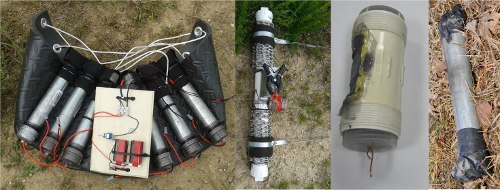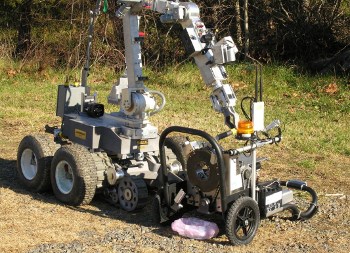 |
| November 20, 2012 | Volume 08 Issue 43 |
Designfax weekly eMagazine
Archives
Partners
Manufacturing Center
Product Spotlight
Modern Applications News
Metalworking Ideas For
Today's Job Shops
Tooling and Production
Strategies for large
metalworking plants
Taking the edge off a pipe bomb, literally

The devastating destruction of several pipe bombs in a car: Homeland Security's Science and Technology Directorate's pipe bomb dismantling mechanism is sophisticated enough to preserve forensic evidence for tracking down the perpetrator. [Image: Israeli Defense Forces]
The Department of Homeland Security (DHS) Science and Technology Directorate's (S&T) new low-cost device for dismantling dangerous pipe bombs may look like a tinkerer's project, but that's no accident. The Semi Autonomous Pipe Bomb End-cap Remover (SAPBER) is unassuming in appearance, but sophisticated enough to preserve the forensic evidence needed to track down the perpetrator.
"From ten paces away, you might mistake the contraption for a pressure washer," says S&T Program Manager Christine Lee. "But step closer, and you'll find an ingenious device bristling with four video cameras, radios, a telescoping mast, cutting wheels, a twisting wrist, an electric motor, and a chain-driven gear -- all powered by a pair of 12-volt batteries."
Thousands of pipe bombs are made each year, and thousands of pipe bomb threats are called into local police and FBI authorities across the country. Many are false alarms, but those that aren't can be deadly.
Dismantling a pipe bomb is tricky and serious business, and missteps during the dismantling process can produce catastrophic results. Law enforcement authorities ideally would like to preserve all evidence related to pipe bomb attacks. But the main focus of responders is the safety of the public, and current pipe bomb render-safe techniques often limit the amount of evidence that can be collected. Not so with SAPBER (say-ber).

A collection of pipe bombs. [Image: Transportation Security Laboratory, ATF, RE2 Inc, Israeli Defense Forces]
Pipe bombs can be constructed from many different pipe materials and filled with many different explosive materials. Making it even more challenging, they can also be constructed with shrapnel on the outside. SAPBER is designed to carefully disassemble the pipe bomb without disturbing the deadly explosive materials inside. Once the pipe bomb is dismantled, the filler explosive materials can then be emptied, and both materials and the pipe itself can be preserved as evidence. The SAPBER system is able to use these special techniques on a wide variety of pipes including straight steel, galvanized steel, copper, and PVC plumbing plastic.
The prototype and its remote-control software were developed by RE2 Inc., of Pittsburgh, PA. As an operator controls the device from a distance, SAPBER takes the pipe bomb from a bomb-disposal robot, disassembles it, empties the pipe, makes a video, and carefully preserves all of the evidence.

A robot positions a pipe bomb on SAPBER, which will take its end caps off, dismantle it, and preserve forensic evidence. [Image: RE2 Inc.]
The 140-lb (64-kg) two-wheeler is small enough to squeeze into a current bomb-squad truck while sharing space with a bomb-disposal robot. Once off the truck, SAPBER is towed into place by hand or by the robot. On-scene, the robot lifts the pipe bomb and gently lays it onto SAPBER's transfer tray to be cleanly disassembled. When the pipe is opened, the material inside -- powder, detonator, shrapnel, and all -- falls into SAPBER's collection trough, to be studied later and used as evidence.
In May, SAPBER underwent trials conducted by the S&T Bomb Squad Test Bed at the Army's Fort Meade. During these trials, the Bureau of Alcohol, Tobacco, Firearms, and Explosives (ATF) fabricated "live" pipe bombs for the Baltimore County Police Department Bomb Squad to test in four different, operational scenarios, and each operator had to control SAPBER remotely, using the tool's video feed. The SAPBER system has also been tested using "live" explosives and has gone through an extensive evaluation by several bomb squads including the Allegheny County and Fairfax County Bomb Squads.
"To keep it affordable (currently around $12,000) and easy to maintain, RE2 Inc. designed and built the device from proven commercial parts that are mass-produced and easily replaced," says Lee.
Everything that S&T's First Responders Group (FRG/R-Tech) funds must appeal to cash-strapped, cost-efficient responders. If SAPBER looks more like a boy's go-cart, and not a sleek racecar, that's no matter to them. Cost-saving is a practice encouraged by S&T's First Responders Group (FRG), whose R-Tech program funded SAPBER's development. The final design was shown to the National Bomb Squad Commander's Advisory Board and municipal bomb squads, and SAPBER proved its mettle -- at the conclusion of the user evaluation, two SAPBER prototypes were transferred to ATF to disarm the scores of pipe bombs its agents have confiscated.
"The most unique feature of the SAPBER is its simplicity and ease of use," says Bomb Squad Commander Corporal Robert Conroy of the Baltimore County Police Department, Hazardous Devices Team. "Personally, I liked that the operating system was computer based and didn't require any extra hardware outside of a standard modem and Wi-Fi hotspot (included with the SAPBER). In addition, the ability of the SAPBER to remotely dismantle pipe bombs in various ways is very unique."
According to Cathy Parker, RE2's manager of business development, "With the SAPBER system, bomb squads will be able to replace dangerous pipe bomb disassembly tools and techniques with a totally remote solution. This tool ushers in a new era of capability for dealing with pipe bombs."
"This means disarming a pipe bomb safely is no longer a pipe dream," says Lee.
Source: Homeland Security's Science & Technology Directorate
Published November 2012
Rate this article
View our terms of use and privacy policy
